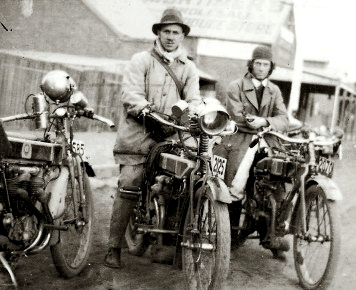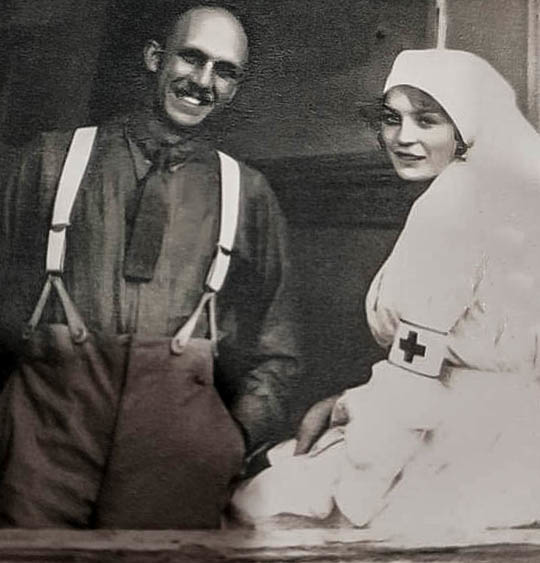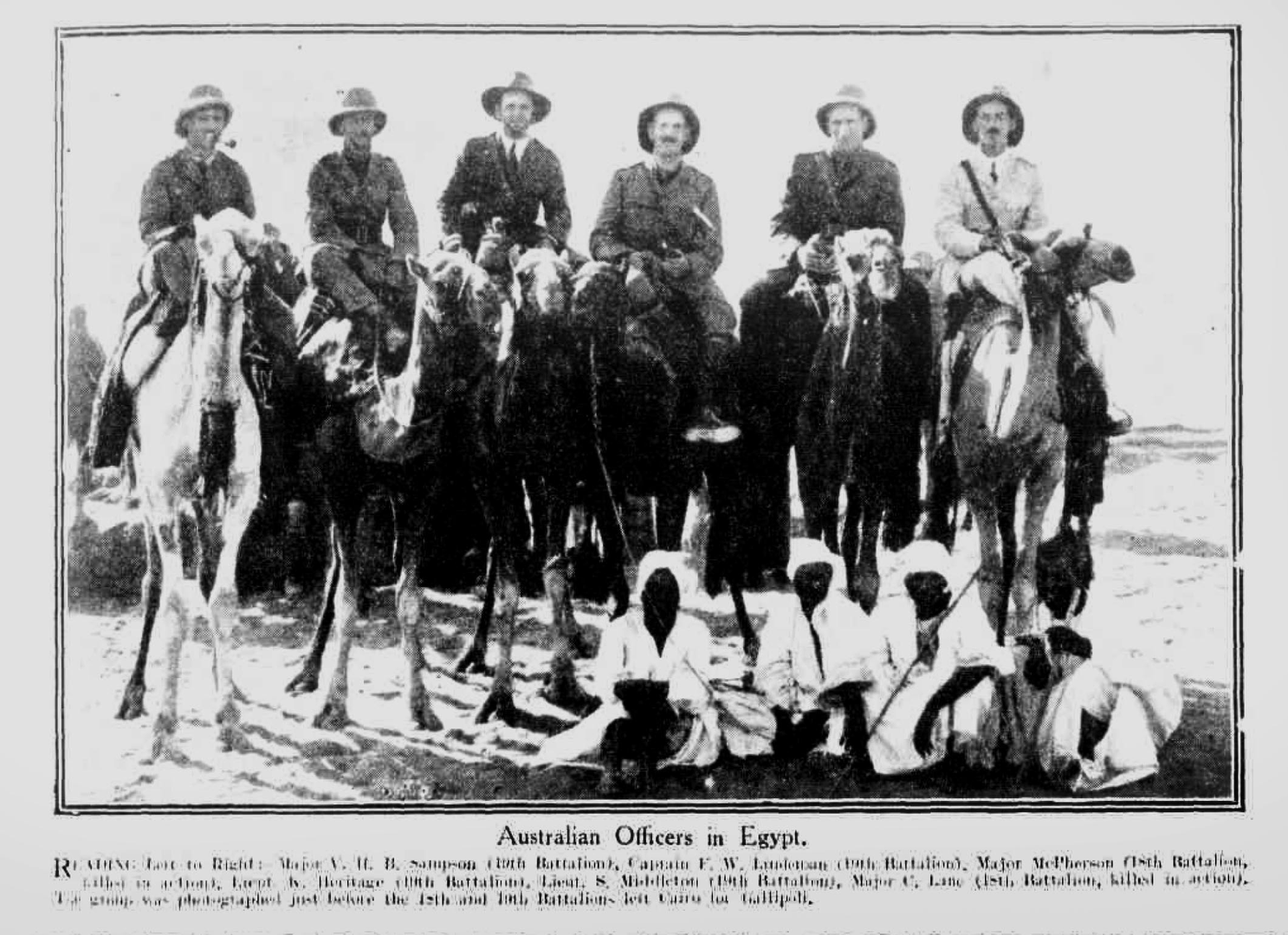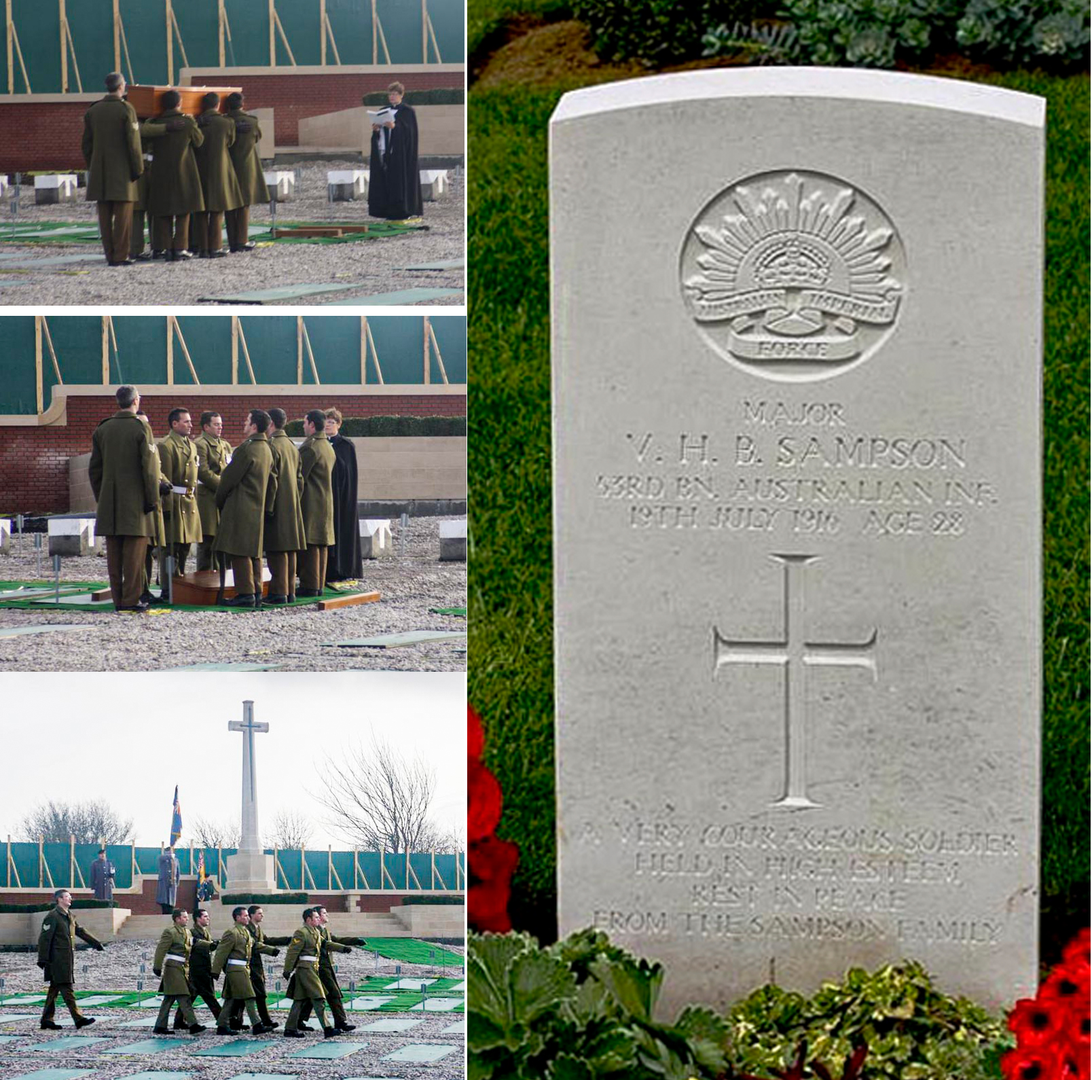Victor Horatio Buller SAMPSON
Eyes hair unknown, Hair eyes unknown, Complexion unknown
Victor Sampson - “Help me in boys, and I will try to throw a few bombs”
Early Life
Victor Horatio Buller Sampson was born on 12 May, 1888 to Burton E. and Catherine T. (Erhart) Sampson, in Manilla, Liverpool, NSW. He was the first of their five children, Victor, Burton, Elsie, Earle and Winnifred. The family has a very long history in Australia, with the arrival of the Langley family, Victor’s maternal side, in Sydney dating back to 1798. They were one of the first free settlers in NSW. They settled in Kelso, on the banks of the Macquarie, and they had the first immigrant children born west of the Blue Mountains.
The Sampson family comes from an Irish whaling captain. Victor’s father, Burton, was a teacher and obviously passed on to Victor the value of a good education. Victor attended Public School and Tamworth Grammar School and earned a Junior University Certificate. He later became a Clerk with the AMP Society. Victor had a large variety of interests.
He had won gold medals for rowing in the Junior Eights, was a good cricketer and an excellent rifle shot. Shortly before he enlisted in the AIF, he won a gold medal in the Auto-Cycling Association of New South Wales’ Triumph Cup. This medal was among the items he took with him when he left Australia for Europe.
He also was a bridge player and a horseman and had an interest in taking photos. His personal effects which were sent home after he died included a pocket Kodak and photographic developing equipment, a Bible, a bridge score pad, a German book, his ACA Triumph Cup Medal, inscribed ‘won by Sampson’, and six pipes.
A Military Career
Victor began his military involvement In March 1910 when he joined the Australian Garrison Artillery in Sydney. He was commissioned as a Lieutenant and became an Area Officer by November. He continued to serve until 1914. When World War I first broke out, he joined the Australian Naval and Military Expeditionary Force in August 1914. They were the first Expeditionary Force to leave Australia. This effort was directed at seizing German interests in New Guinea, particularly in New Britain.
Victor was commissioned as a Lieutenant and was posted in Rabaul, New Guinea as second in command of H Company. He served about 9 months in Rabaul.
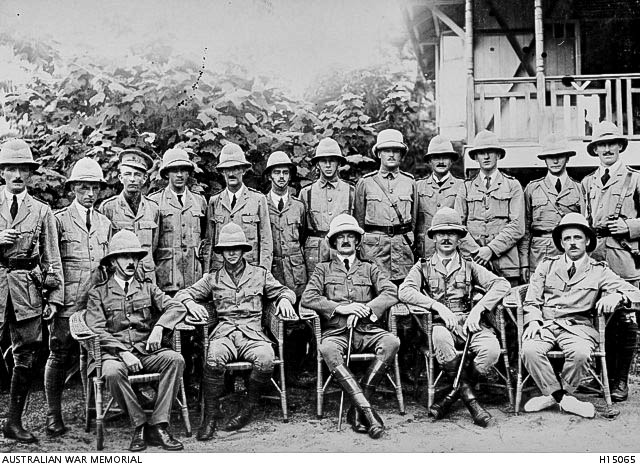
Victor Sampson, back row 4th from left
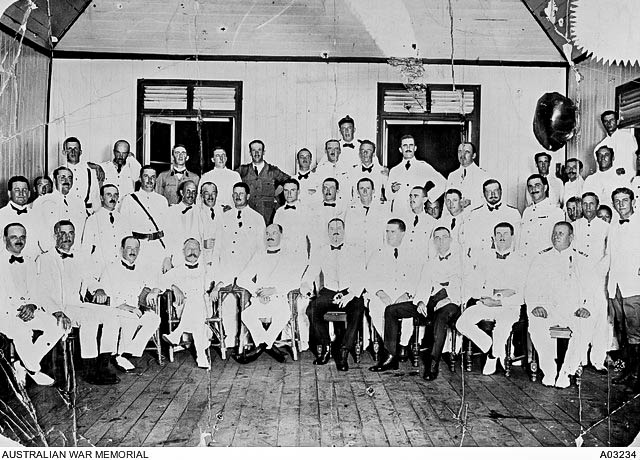
Victor 2nd row, 5th from left
Things happened fast from then. On his return from Rabaul, he joined the Australian Imperial Force in May 2015 and was assigned to the 19th Battalion, which had just been created in March. He was promoted to Captain and sent to attend Officers’ School. He was promoted to Major on the first of June. The 19th departed from Sydney on 25 June 1915 aboard the Ceramic, headed for Gallipoli, He arrived in August. Victor was in command of B Company.
While the 19th were in Gallipoli, they did have responsibility for Pope’s Post, a key monitoring point for Turkish activity, but they were not in any major engagements. Victor came down with malaria while in Gallipoli and in late October was sent to England for treatment at the 3rd London General Hospital, Wandsworth. In January 1916, he was finally declared fit for service.
In mid-February 1916 he rejoined the 19th who had left Gallipoli and were at the Tel el Kebir camp in Egypt.
With all of the soldiers arriving from Australia, major reorganizations were ongoing. Victor was initially assigned to newly formed 55th Battalion in April, but was transferred to the 53rd Battalion on 9 June as the staffing of these two new battalions was stabilised. He was assigned the command of C Company. The 53rd was soon called to support the Western Front and the 32 officers and 958 soldiers left Alexandria on 19 June on the Royal George. After arriving in Marseille on the 28th, they had a 62 hour train ride to Thiennes. It was noted that:
their reputation had evidently preceded them as they were well received by the French at the towns all along the route.
Fromelles

After several days of marching the 35 km to Fleurbaix, they were settled into billets on 16 July. Early the next morning, the 53rd were moved straight into the front lines for an attack, but it was cancelled due to bad weather. They remained in the trenches in relief of the 54th. On the 19th, heavy bombardment was underway from both armies by 11.00AM. At 4.00 PM the 54th rejoined on their left. All were now in position for battle. The main objective for the 53rd was to take the trenches to the left of a heavily armed, elevated German defensive position, the ‘Sugar Loaf’, which dominated the front lines.
If the Sugar Loaf could not be taken, the 53rd and the other battalions would be subjected to murderous enfiled fire from the machine guns and counterattacks from that direction. As they advanced, they were to link up with the 60th and 54th Battalions on their flanks. The Australians went on the offensive at 5.43 PM. They moved forward in four waves – half of A & B Companies in each of the first two waves and half of Victor’s C Company and D Company in the third and fourth. They did not immediately charge the German lines, they went out into No-Man’s-Land and laid down, waiting for the British bombardment to lift.
At 6.00 PM the German lines were rushed. The 53rd were under heavy artillery, machine gun and rifle fire, but were able to advance rapidly. Corporal J.T. James of C Company (3550) reported:
“At Fleurbaix on the 19th July we were attacking at 6 p.m. We took three lines of German trenches”
As below, the 14th Brigade War Diary notes that the artillery had been successful and “very few living Germans were found in the first and second line trenches”, BUT within the first 20 minutes the 53rd lost ALL the company commanders, ALL their seconds in command and six junior officers.
Source AWM C E W Bean, The AIF in France, Vol 3, Chapter XII, pg 369
As reported by Corporal J.T. James of C Company (3550), Victor was bravely leading his Company in this early part of the battle:
“At Fleurbaix on the 19th July we were attacking at 6 p.m. We took three lines of German trenches[;] we were driven out of them at daylight. I saw Major Sampson wounded about 10 yards in front of the 1st German line - he was wounded very badly about the body. He said - "Help me in boys, and I will try to throw a few bombs". We were at the time bombing the Germans who were retreating to their 2nd line.”
Private J. Wiggington (3533) reported:
“I saw him bringing reinforcements across No Man's Land at Fleurbaix on July 19th. Later on as I came back I saw his dead body lying out about 50 yards from the German front line. He had been killed by M.G. (machine gun) fire. I passed close to his body and am certain he was dead. He was my Coy. Commander.”
Some of the advanced trenches were just water filled ditches, which needed to be fortified by the 53rd to be able to hold their advanced position against future attacks. After the initial onslaught, they were able to link up with the 54th on their left and, with the 31st and 32nd, occupy a line from Rouges Bancs to near Delangre Farm, but the 60th on their right had been unable to advance due to the devastation from the machine gun emplacement at the Sugar Loaf.
They held their lines through the night against “violent” attacks from the Germans from the front, but their exposed right flank had allowed the Germans access to the first line trench BEHIND the 53rd, requiring the Australians to later have to fight their way back to their own lines. By 9.00 AM on the 20th, the 53rd received orders to retreat from positions won and by 9.30 AM they had “retired with very heavy loss”.
Source AWM4 23/70/2 53rd Battalion War Diaries July 1916 page 7
Of the 990 men who had left Alexandria just weeks before, the initial count at roll call was 36 killed, 353 wounded and 236 missing:
“Many heroic actions were performed.”
To get some perspective of the battle, when Charles Bean, Australia’s official war historian, attended the battlefield two and half years later, he observed a large amount of bones, torn uniforms and Australian kit still on the battlefield. The final impact of the battle on the 53rd was 245 soldiers were killed or died from their wounds and, of this, 190 were not able to be identified, including Victor.
Respected by his Mates
Not only was Victor gallant in battle, he was obviously well respected by those who had been under his command, as soldiers from his earlier assignments had heard of his death and remembered him well.
Private J.A. Powell (620), B Company, 19th Bn said:
“I remember Major Victor Sampson. He was taken with malaria on the peninsular [sic]. I saw him lying ill in his dug-out with the doctor attending him. He was sent to England, and was absent a long time. He came out again in March and I saw him at (?). He was not appointed to our Battn., but joined the 55th and I was told by some men of the 55th that he was killed going over the top at Fleurbaix sometime in July. I knew him very well.”
Sergeant A.G. Ellis (1457), Lewis Machine Gun Section, 19th Battalion:
“He was our adjutant for a long time and was my officer when he was a lieut. on our first expedition - to New Guinea. He left us about May and took command of a new Battn in the 1st. Div. We had word from them in Sept. that he was killed.”
Even General Birdwood, the British commander of the Anzac forces and the person who gave Anzac Cove its name, paid his respects to Victor:
“He was a very gallant officer.”
Back Home
With the distance, uncertainty and the chaos of the battle, news travelled slowly back home, however. There were many communications with the Army from his family and girlfriend, Marie White, who was a nurse at the Thrilmere Sanatorium, seeking news of Victor. Victor was 28 when he died. He was declared as killed in action. His body was not found by the Australians.
He received the 1914-15 Star, the British War Medal and the Victory Medal, a Memorial Plaque and a Memorial Scroll.
Closure – 94 years later
After the battle, the Germans had dug a mass grave which contained the bodies of 250 soldiers they recovered, but this grave was not discovered until 2008. An ADF project was undertaken to match up DNA of the soldiers in the grave with living relatives for identification. The Fromelles Association has continued this soldier identification project. As of 2024, 180 of the 250 soldiers have been identified. Victor’s remains were among the 97 soldiers initially identified from the site in 2010.
The Fromelles (Pheasant Wood) Military Cemetery was built in 2009-10 to honour these soldiers. Victor was reburied with full military honours on 5 February 2010. Victor’s remains are buried in Plot IV, Row C, Grave No. 1.
His headstone reads:
A VERY COURAGEOUS SOLDIER
HELD IN HIGH ESTEEM
REST IN PEACE
FROM THE SAMPSON FAMILY
He is also commemorated on the VC Corner Memorial Panel 6, near Fromelles, France and at the Australian War Memorial, Panel 158. Victor was not the only one in the family to succumb to WWI. His cousin, Lieutenant Francis Horatio Faddy of the 13th Battalion was killed in action on 3 May 1915 at the 'Chess Board', Pope's Hill, Gallipoli. Francis was just 21 years old.
For more information about Victors life, the Students of St. Mary’s Cathedral College in Sydney have created a video of Victor Sampson’s contributions. https://vimeo.com/channels/smccsydney/14148508
The Fromelles Association would love to hear from you

Contacts
(Contact: carla@fromelles.info or geoffrey@fromelles.info).
(Contact: army.uwc@defence.gov.au or phone 1800 019 090).
Donations
If you are able, please contribute to the upkeep of this resource.
(Contact: bill@fromelles.info ).

